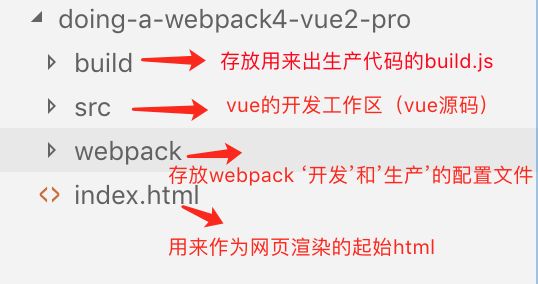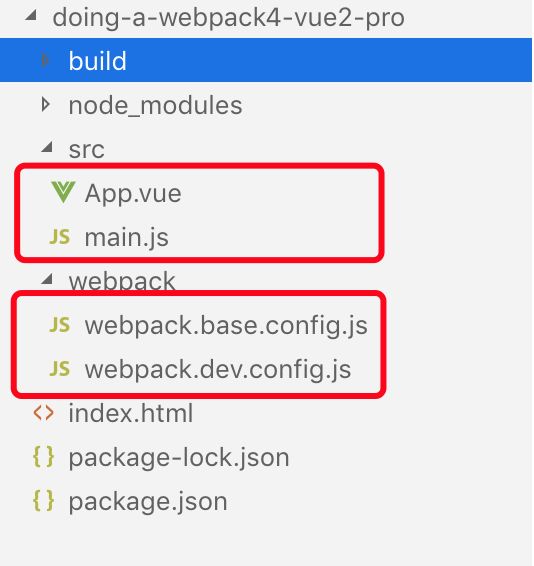基础目录结构以及各个文件的作用
初始npm项目
npm init
一路回车,一律使用默认的npm项目配置
package.json修改scripts
如下:
{
"name": "doing-a-webpack4-vue2-pro",
"version": "1.0.0",
"description": "超级详细的手写webpack4配置来启动vue2项目(附配置作用)",
"main": "index.js",
"author": "",
"license": "ISC",
"scripts": {
"dev": "webpack-dev-server --config webpack/webpack.dev.config.js"
},
"engines": {
"node": ">= 8.0.0",
"npm": ">= 3.0.0"
},
"browserslist": [
"> 1%",
"last 2 versions",
"not ie <= 8"
]
}
说明:
npm run dev用来启动命令webpack-dev-server --config webpack/webpack.dev.config.js
这里将开发环境(development)的配置 webpack/webpack-dev-config.js 传入到启动的server config中。 详情
故这里需要做两件事情:
a.npm install webpack-dev-server -D开发依赖
b. 书写 webpack.dev.config.js
书写 webpack.dev.config.js
说明:
由于 webpack.dev.config.js 与 webpack.prod.config.js 近似,所以手写一个 webpack.base.config.js来减少配置耦合量。
提示:base.config与dev.config需要用webpack提供的webpack-merge来合并
故这里需要做两件事情:
a.npm install webpack-merge -D这个放到后面安装config需要的依赖中一起做,稍后会写到
b. 书写 webpack.base.config.js
书写 webpack.base.config.js
webpack/webpack.base.config.js
const path = require("path")
const { VueLoaderPlugin } = require('vue-loader')
const ifProd = process.env.NODE_ENV === 'production' ? true : false
const config = {
dev: {
mode: 'development',
assetsPublcPath: '/',
assetsSubDirectory: './'
},
prod: {
mode: 'production',
index: path.resolve(__dirname, "../dist/index.html"),
assetsPublcPath: path.resolve(__dirname, "../dist"),
assetsSubDirectory: './'
}
}
module.exports = {
mode: ifProd ? 'production' : 'development',
context: path.resolve(__dirname, '../'),
entry: {
app: './src/main.js'
},
output: {
filename: '[name].bulde.[hash:10].js',
path: ifProd ? config.prod.assetsPublcPath : config.dev.assetsPublcPath
},
resolve: {
extensions: ['.js', '.vue'],
},
devServer: {
quiet: true
},
module: {
rules: [
{
test: /\.vue$/,
use: [
{
loader: 'vue-loader',
}
]
},
{
test: /\.js$/,
exclude: /node_modules/,
loader: 'babel-loader',
options: {
presets: ['babel-preset-env']
}
},
{
test: /\.css$/,
use: ['vue-style-loader', 'css-loader']
}
]
},
plugins: [
new VueLoaderPlugin()
]
}
我们可以看到,这里base.config需要的开发依赖有:
babel-loader@7(7.x版本需要配合babel-corebabel-preset-env)
webpack(4.x版本需要配合webpack-cli)
css-loader(需要配合vue-style-loader)
vue-loader(需要配合vue-template-compiler)
故在命令行执行如下命令
npm install -D babel-loader@7 babel-core babel-preset-env webpack webpack-cli
npm install -D css-loader vue-style-loader vue-loader vue-template-compiler
详细的配置说明解释几天后给出
回到 webpack.dev.config.js
webpack/webpack.dev.config.js
const BaseConfig = require("./webpack.base.config")
const merge = require("webpack-merge")
const HtmlWebpackPlugin = require('html-webpack-plugin')
module.exports = merge(BaseConfig, {
plugins: [
// https://github.com/ampedandwired/html-webpack-plugin
// 这是一个webpack的插件来创建html文件渲染你的webpack生成的bundle
new HtmlWebpackPlugin({
// 写入bundle的那个index.html
filename: 'index.html',
template: 'index.html'
})
]
})我们可以看到,这里dev.config需要的开发依赖有:
webpack-merge(前面提到的用来将dev.config和base.config合并的依赖)
html-webpack-plugin
故在命令行执行如下命令
npm install -D html-webpack-plugin webpack-merge
可以开始写vue啦!
src/main.js
我们在上面的 webpack.base.config.js 中写到了 entry: {app: './src/main.js'}
这就是我们的vue入口了。如下:
import Vue from "vue"; // 引入vue
import App from "./App"; // 引入组件App
new Vue ({
el: '#app', // 挂载到index.html中的#app上
render: h => h (App) // 用App.vue渲染
})
src/App.vue
简单的一个首页
Success
如上,我们需要引入vue,所以:
npm install vue -S(自动安装2.x版本的vue)
最后
代码结构:
index.html
doing
运行项目
npm run dev
源码地址
具体的项目源码地址: https://github.com/Sotyoyo/do...
源码与本文章稍有出入,后期会做到统一,希望给个star支持一下!

